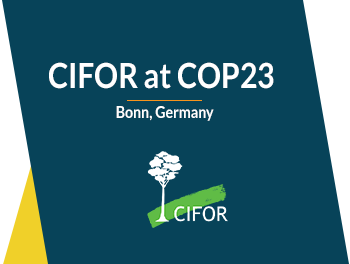In the hot, tented meeting rooms of the global climate conference in Bonn, peatlands are never far away.
This is true as Germany has expanses of peatlands, much of them drained for agriculture and now emitting carbon into the atmosphere; and it is true as a host of panels, side dialogues and workshops are directing their discussions to these wet and watery spaces.
At an event organized by the Center for International Forestry Research (CIFOR) and Indonesia’s Peatlands Restoration Agency (BRG), CIFOR Scientist Daniel Murdiyarso called for collective action on peatlands in Indonesia, an archipelago that hosts 65 percent of the world’s peatlands.
He said in an interview after the discussion, “As part of Indonesia’s Nationally Determined Contributions [NDCs] agreed to at COP21 in Paris, the country committed to reducing its emissions by 29 percent by 2030. This includes the restoration of two million hectares of degraded peatlands.
“But what progress has been made? How can we monitor the advancements on the ground?”
EYES ON THE PRIZE
In her presentation, CIFOR Scientist Rosa Maria Roman-Cuesta said, “Indonesia is not alone in the problem of peatlands,” before moving into her case study of peatlands in the Okavango River Delta in Botswana, with peat forming there in a different hydrological fashion than in Indonesia.
Roman-Cuesta and fellow researcher Thomas Gumbricht have developed a new methodology to monitor peatland degradation and restoration combining remote-sensed rainfall and soil moisture trends. The area they study in Botswana is dependent on water from two rivers, and the water that reaches the delta ultimately evaporates or transpires.
Indonesia is not alone in the problem of peatlands
“We hope this monitoring work, which disaggregates climate variability and human action, can be applied across the tropics. With the on-the-ground validation, the work harnesses the collective efforts of existing restoration work, local communities and scientists,” she said.
A collaboration with National Geographic’s Okavango Wilderness Project is just beginning, with the work finding peat in new areas while looking at the ecology and threats to this rich riverine delta and informing Gumbricht and Roman-Cuesta’s research.
For panelist Dharsono Hartono of PT Rimba Makmur Utama, his company is scrutinizing the progress of its cooperation with farmers to reduce peatland degradation and peat fires over 100,000 hectares of land.
“The focus is how we can make communities more productive in their agroforestry practices to reduce the pressure on peat swamp forests … now we are getting the traction. It wasn’t easy to convince people two years ago that it worked but after two harvest cycles farmers are convinced,” he said in an interview in Bonn before the event.
PEOPLE POWER
Dharsono described his efforts in Katingan in Central Kalimantan, Indonesia, to understand what local communities need and want and to ensure they feel the benefits from halting their usual practices.
“We looked into the issue of slash and burn and asked, ‘How can you change the behavior of communities?’” he said, adding, “There needs to be time, trust and proof that it works.”
Offering alternatives to burning land for crops, Dharsono’s project provides elements that create a more productive soil than burning, agro-ecology incentives and the purchase of excess vegetables grown on those lands, among others.
As panel moderator, Murdiyarso stressed the need to encourage communities to stop digging the canals that drain peatlands of their moisture, and to stop setting fires, while talking of the reasons behind those practices.
The tools are there in the articles in the Paris Agreement on mitigation and adaptation, in the NDCs
In a later interview, he anchored the discussion to the climate negotiations currently ongoing. “We need to think about how global processes affect wetlands, and, alternately, how local processes and what people do in their day-to-day life can impact international policy.”
“The tools are there in the articles in the Paris Agreement on mitigation and adaptation, in the NDCs,” he added.
So while peat is definitely figuring in the international climate discussions at COP23, the ground-level work remains, and matters.
BOGGED DOWN?
The following day at an entirely different discussion, this time on global peatlands, panelist Hans Joosten of Greifswald University asked, “How to deal with the cryptic, delicate, diverse but explosive character of peatlands?”
He spoke of the stocks in Belarus, Iceland, Papua New Guinea and Kenya, and newly discovered areas in the Caribbean, and then offered the seemingly obvious suggestion – flowing throughout the expert panels in Bonn – to “keep peatlands wet”, something, unfortunately, we as humans have been unable to do.
At the CIFOR event, BRG Head Nazir Foead responded to an audience question about prioritizing restoration and financing: “The Indonesian government now has a policy on ecosystem restoration and a budget, and we are also encouraging the private sector to join in.”
Dharsono’s project in Indonesian Borneo is one pioneer case, now selling carbon credits approved by the Verified Carbon Standard.
“From a business model perspective we are trying to show you can make money protecting and preserving peatlands,” he said.
These landscapes are essentially swamps, and so many in Bonn are directing targeted dialogues toward these seemingly distant ecosystems. Joosten offered a final testament worthy of a COP23 slogan – that there is “no Paris without peatlands.”
And as to Indonesia’s peatlands, Murdiyarso said, “Collective, communal action is the only way to achieve our conservation and restoration goals.”
We want you to share Forests News content, which is licensed under Creative Commons Attribution-NonCommercial-ShareAlike 4.0 International (CC BY-NC-SA 4.0). This means you are free to redistribute our material for non-commercial purposes. All we ask is that you give Forests News appropriate credit and link to the original Forests News content, indicate if changes were made, and distribute your contributions under the same Creative Commons license. You must notify Forests News if you repost, reprint or reuse our materials by contacting forestsnews@cifor-icraf.org.
